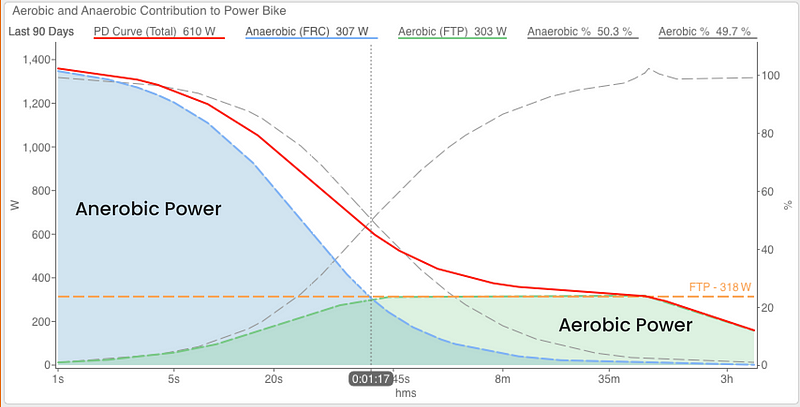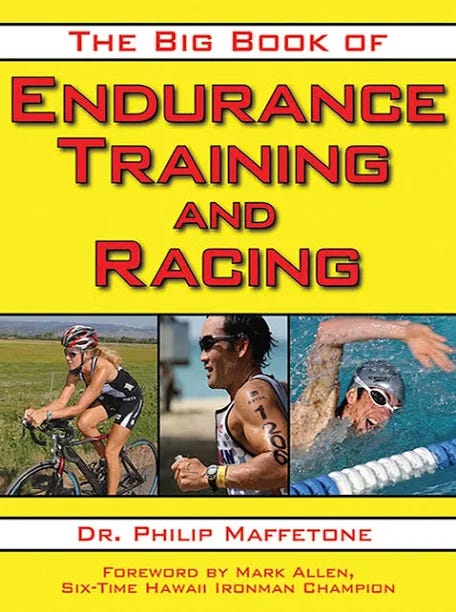Zone 2 Training: Hmm, Is Cycling Still an Aerobic Sport?
The legendary Cycling Coach, Joe Friel suggests a strong aerobic engine is what gets you in the game. Cycling is 95–99% aerobic other than short sprint races. So unless you are a podium finisher and/or doing doing sprint type events you should focus most of seasonal training on improving your aerobic capacity. Sprint strength makes you feel good and strong and it might even improve an FTP test, especially a ramp test, but it’s not what “keeps you in the game.”
Anaerobic work capacity, AWS or W’ does have value but only after you have a solid aerobic base. For example your anaerobic sprints can help you bridge the gaps to catch a faster peloton, or keep your fast friends from sprinting away from you. But if you don’t have that aerobic power “base” you are not going to be there in the first place.
As you can see below, after about 8-minutes anaerobic provides a small percent in helping you keep up… and after 35 minutes forget it.

So your slow twitch or “aerobic muscles” and system are very valuable. How do you best train them? Lots of “Zone 2.”
In this video below by GCN with Dr Iñigo San Millán, coach to Tadej Pogačar talking about how to choose your intensity for Zone 2 as well as the the benefits of Zone 2. It’s not exactly the same as power based Zone 2 based on your FTP but generally it’s likely to be around middle to upper heart rate Zone 2.
[YouTube Video](
)Dr Iñigo’s makes the point that having a great aerobic / slow twitch muscle system will help you utilize lactate for fuel which also removes the lactate more rapidly. This allows you to spend more time around you lactate threshold (FTP) or ultimately raising your FTP.
He also states: Focus your training on targeting energy systems. Power zone focus is less important. He does feel that Zone 3 of Coggan’s Zones is not focusing on any particular energy system so if you are limited on time , focusing on your energy systems becomes extra critical.
Heart Stroke Volume.
For those of us that are not elite athletes, there is another point to consider. Improve your heart stroke volume meaning the amount of blood your heart can pump in a single beat.
As you improve your aerobic system, you improve your stroke volume. There are many signs this is true. One that most of us are aware of is that even with lots of training we do not increase our maximum heart rate and it’s not something we work on to improve. So one of the primary ways to get more blood flow and more air to your muscles, is that you need to improve your heart stroke volume.
It’s very obvious stroke volume increases to anyone that starts training regularly. You see this because your night time or resting heart rate continues to drop. I was not training much in my 40s and at 46 my resting heart rate was about 60 bpm. After training for the last 10-years, my resting heart rate is down around 46 bpm. This came with semi-consistent primarily Zone 1 and 2 training. As you may know many pros have a resting heart rate in the 30s.
An interesting concept is that from Zone 1 to Zone 2, your your stroke volume keeps increasing. Once your aerobic threshold around the top of Zone 2, your stroke volume stops increasing and all the additional oxygen comes from increased heart rate. So if you cause adaption in stroke volume, just like everything else you need to stress your “stroke volume” close to it’s maximum, which happens to be your aerobic threshold (AeT)… So in this case hard training is zone 2 and you don’t need to do more than zone 2. One idea I like is Coach Chad from TrainerRoad that says “minimum effective dose.” By his definition that would be zone 2 for aerobic improvement.
Our Coach Andrea also suggests spending lots of time in zone 2. The year might start out between 100/0 and 95/5 meaning 100% zone one and two or 95% zone one and two and slowly move towards 80/20 towards your peak season or possibly even up to 70/30 depending on how much you are training.
These are just rough estimates but the point is most of your year is doing easy zone 1, zone 2 training. Ultimately these variable % of time in zone is just a periodized version of Dr Seiler’s Polarizied Training.
We would not call zone 3 “no mans land” and it can be a part of a lot of fun rides but it just does not need to be a primary target zone and if you see yourself spending too much time there you likely need to learn to back off for your best performance.
So Zone 2 also is great for health. There are so many good reasons to learn how to train correctly which means lot’s of constraint. Consistent Zone 2 can be very challenging, but most of the best athletes have the most control of their life and their training. They don’t just go out and push it medium hard all the time. Neither should you.
So now what?
If this Zone 2 focus makes sense to you and you want to become the “king or queen” of zone 2 training, it’s fairly well accepted that Coach and Author Dr Phil Maffetone is a leader in low heart-rate training.
To clarify, Dr Iñigo San Millán is ultimately talking about low heart rate training. Dr Maffetone has also trained the best of the best in runners and triathletes, and gives a clear strategic program on how to make sure you become the ultimate fat burning machine.
As a highlight, here are some of Dr Maffetone’s suggestions
- Don’t eat carbs before your fat burning workout, if it is a long one maybe add them later in the workout. Carbs will drive your body towards burning glucose faster.
- Spend long periods of time doing pure base, and learn to experiment to see if more anaerobic work slows your aerobic progression.
- Do a slow warmup process. If you shock your body into thinking it’s doing something, it will switch to glucose burning mode.
- Focus on never going over over your AeT to ensure you don’t get out of fat burning mode. Generally it’s always some mix of fat and carbs but the goal is to keep it very predominantly fat utilization.
- Maffetone has a 180 formula which some people don’t agree with but the main point of Maffetone and Dr Iñigo San Millán is, if you pay close attention you can learn to feel when you are in fat burning mode and set a baseline heart rate target. There are other methods of determining this as well. Lab tests, SMO2 devices, HRV based Android app called FatMaxxer for example… I am sure google has a lot of choices.
- Maffetone says it is safer and no down side to erroring on the low side of your top end of AeT. For me it is about 68% of max HR but 65–70% is pretty common. Some strong athletes or “freaks” :) could be higher than 70%.
Here is one of Maffetone’s book, they are all good and mostly similar. Maffetone’s work is especially valuable for people that tend to over train and push themselves too much.

You can get it on Amazon here
https://www.amazon.com/Big-Book-Endurance-Training-Racing/dp/1616080655
I hope this helps. The TrainerDay Android and iOS apps work well for training by heart rate with simple access to + — to adjust your target power.
https://www.amazon.com/Big-Book-Endurance-Training-Racing/dp/1616080655
Related Articles
Zone2 with HR+
The Ultimate Way — Zone 2 Training The TrainerDay mobile app now has the ultimate way to do heart rate based training. !...
How to Use Heart Rate Zone Training Outside
We have a power zone to HR zone conversion process that allows you to take our power based workouts outside with your he...
The Benefits Of A Polarized Approach To Cycling Training
The Benefits of a Polarized Approach to Cycling Training Endurance sports demand discipline, dedication, and a well-stru...
Ready to Optimize Your Training?
Join thousands of cyclists using TrainerDay to reach their performance goals.
Start Training with TrainerDay
